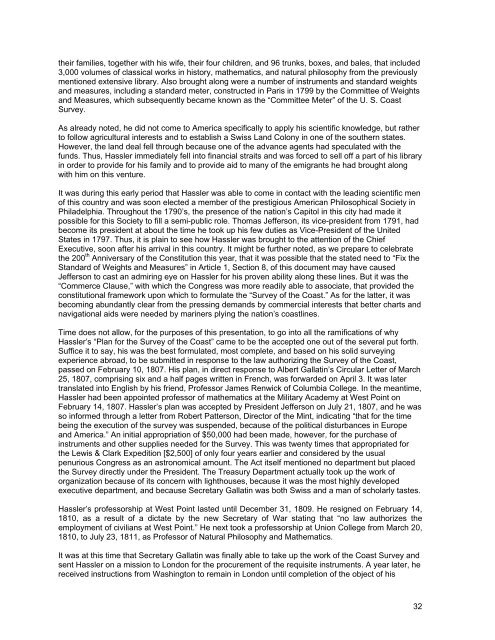Ferdinand Rudolph Hassler - NIST Virtual Library - National Institute ...
Ferdinand Rudolph Hassler - NIST Virtual Library - National Institute ...
Ferdinand Rudolph Hassler - NIST Virtual Library - National Institute ...
You also want an ePaper? Increase the reach of your titles
YUMPU automatically turns print PDFs into web optimized ePapers that Google loves.
their families, together with his wife, their four children, and 96 trunks, boxes, and bales, that included<br />
3,000 volumes of classical works in history, mathematics, and natural philosophy from the previously<br />
mentioned extensive library. Also brought along were a number of instruments and standard weights<br />
and measures, including a standard meter, constructed in Paris in 1799 by the Committee of Weights<br />
and Measures, which subsequently became known as the “Committee Meter” of the U. S. Coast<br />
Survey.<br />
As already noted, he did not come to America specifically to apply his scientific knowledge, but rather<br />
to follow agricultural interests and to establish a Swiss Land Colony in one of the southern states.<br />
However, the land deal fell through because one of the advance agents had speculated with the<br />
funds. Thus, <strong>Hassler</strong> immediately fell into financial straits and was forced to sell off a part of his library<br />
in order to provide for his family and to provide aid to many of the emigrants he had brought along<br />
with him on this venture.<br />
It was during this early period that <strong>Hassler</strong> was able to come in contact with the leading scientific men<br />
of this country and was soon elected a member of the prestigious American Philosophical Society in<br />
Philadelphia. Throughout the 1790’s, the presence of the nation’s Capitol in this city had made it<br />
possible for this Society to fill a semi-public role. Thomas Jefferson, its vice-president from 1791, had<br />
become its president at about the time he took up his few duties as Vice-President of the United<br />
States in 1797. Thus, it is plain to see how <strong>Hassler</strong> was brought to the attention of the Chief<br />
Executive, soon after his arrival in this country. It might be further noted, as we prepare to celebrate<br />
the 200 th Anniversary of the Constitution this year, that it was possible that the stated need to “Fix the<br />
Standard of Weights and Measures” in Article 1, Section 8, of this document may have caused<br />
Jefferson to cast an admiring eye on <strong>Hassler</strong> for his proven ability along these lines. But it was the<br />
“Commerce Clause,” with which the Congress was more readily able to associate, that provided the<br />
constitutional framework upon which to formulate the “Survey of the Coast.” As for the latter, it was<br />
becoming abundantly clear from the pressing demands by commercial interests that better charts and<br />
navigational aids were needed by mariners plying the nation’s coastlines.<br />
Time does not allow, for the purposes of this presentation, to go into all the ramifications of why<br />
<strong>Hassler</strong>’s “Plan for the Survey of the Coast” came to be the accepted one out of the several put forth.<br />
Suffice it to say, his was the best formulated, most complete, and based on his solid surveying<br />
experience abroad, to be submitted in response to the law authorizing the Survey of the Coast,<br />
passed on February 10, 1807. His plan, in direct response to Albert Gallatin’s Circular Letter of March<br />
25, 1807, comprising six and a half pages written in French, was forwarded on April 3. It was later<br />
translated into English by his friend, Professor James Renwick of Columbia College. In the meantime,<br />
<strong>Hassler</strong> had been appointed professor of mathematics at the Military Academy at West Point on<br />
February 14, 1807. <strong>Hassler</strong>’s plan was accepted by President Jefferson on July 21, 1807, and he was<br />
so informed through a letter from Robert Patterson, Director of the Mint, indicating “that for the time<br />
being the execution of the survey was suspended, because of the political disturbances in Europe<br />
and America.” An initial appropriation of $50,000 had been made, however, for the purchase of<br />
instruments and other supplies needed for the Survey. This was twenty times that appropriated for<br />
the Lewis & Clark Expedition [$2,500] of only four years earlier and considered by the usual<br />
penurious Congress as an astronomical amount. The Act itself mentioned no department but placed<br />
the Survey directly under the President. The Treasury Department actually took up the work of<br />
organization because of its concern with lighthouses, because it was the most highly developed<br />
executive department, and because Secretary Gallatin was both Swiss and a man of scholarly tastes.<br />
<strong>Hassler</strong>’s professorship at West Point lasted until December 31, 1809. He resigned on February 14,<br />
1810, as a result of a dictate by the new Secretary of War stating that “no law authorizes the<br />
employment of civilians at West Point.” He next took a professorship at Union College from March 20,<br />
1810, to July 23, 1811, as Professor of Natural Philosophy and Mathematics.<br />
It was at this time that Secretary Gallatin was finally able to take up the work of the Coast Survey and<br />
sent <strong>Hassler</strong> on a mission to London for the procurement of the requisite instruments. A year later, he<br />
received instructions from Washington to remain in London until completion of the object of his<br />
32
















